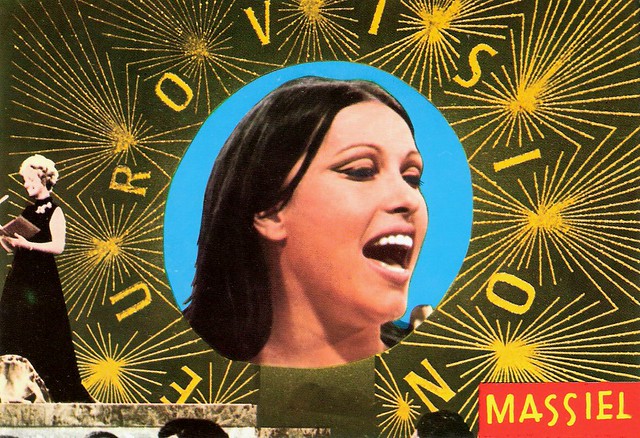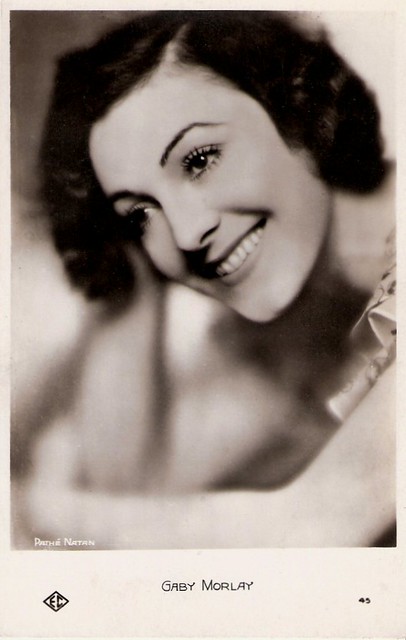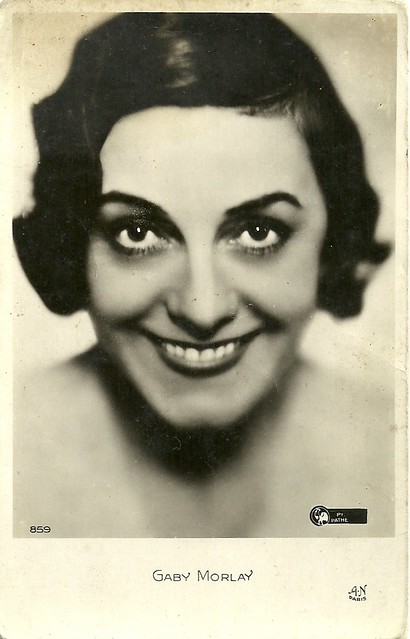Dark-haired and elegant German film actress Adelheid Seeck (1912-1973) appeared in 27 films between 1941 and 1972. Her West German films of the 1950s had class and were often selected for the Berlin International Film Festival.
![Adelheid Seeck]()
German postcard by Ross-Verlag, no. A 3404/1, 1941-1944. Photo: Baumann / Terra.
Adelheid Seeck was born in Berlin in 1912 (although some sources say 1899 and other 1913).
She had ballet lessons from dancer and choreographer Max Terpis and from 1933, she performed as a dancer and at the Kabarett der Komiker. After private acting lessons, she made her stage debut in 1939 at the Schlesischen Landesbühne in Bunzlau (now Boleslawiec).
From 1940 on, she played at the Berliner Staatstheater under the direction of Gustaf Gründgens. This stopped when all the theatres had to close in the autumn of 1944.
In 1941 her film career started. She was the wife of Willy Fritsch in Leichte Muse/Light Muse (Arthur Maria Rabenalt, 1941).
In the following years, she played lead roles in Tierarzt Dr. Vlimmen/Veterinarian Dr. Vlimmen (Boleslaw Barlog, 1944) featuring Hans Söhnker, and the Ufa production Die Brüder Noltenius/The Noltenius Brothers (Gerhard Lamprecht, 1945) starring Willy Birgel.
German Wikipedia describes her as ‘posh’ and ‘restrained’ and her postcards of the war period indeed show an elegant lady.
After the end of the war, she returned to the theatre and appeared at the Theater der Stadt Heidelberg. From 1948 on, she performed at the Städtischen Bühnen Düsseldorf, again under Gustaf Gründgens. Later she worked as a free-lance actress.
She also appeared in films again, such as in Wohin die Züge fahren/Wherever the Trains Travel (Bosleslaw Barlog, 1949) with Heidemarie Hatheyer and Carl Raddatz, and Drei Mädchen spinnen/Three girls spin (Carl Froelich, 1950) as the wife of Albrecht Schoenhals.
![Adelheid Seeck]()
German postcard by Film-Foto-Verlag, no. 3557/1, 1941-1944. Photo: Baumann / Terra.
During the post-war years, Adelheid Seeck often played princesses and countesses in the West-German cinema.
She played Princess Irene of Prussia in Anastasia, die letzte Zarentochter/The Story of Anastasia (Falk Harnack, 1956), based on the true story of a woman in Berlin (Lilli Palmer) who was pulled from the Landwehr Canal in 1920 and who later claimed to be Anastasia, the youngest daughter of Czar Nicholas II of Russia. The entire Romanov family was executed in the Russian Revolution, but this was not confirmed until their graves were discovered in 1991 and 2007.
For her performance as Sylvia Angermann in Teufel in Seide/Devil in Silk (Rolf Hansen, 1956), Seeck won the Filmband in Silber award for Best Female Supporting Player.
She then co-starred with O.E. Hasse and Ulla Jacobsson in the West German crime film Die Letzten werden die Ersten sein/The Last Ones Shall Be First (Rolf Hansen, 1957), which was entered into the 7th Berlin International Film Festival.
She had a supporting part in the drama Mädchen in Uniform/Girls in Uniform (Géza von Radványi, 1958). Hal Erickson at AllMovie: “Christa Winsloe's novel Maedchen in Uniform was first filmed in Germany in 1933. The story, about a sensitive schoolgirl's lesbian attachment to her headmistress, was handled tastefully, albeit with remarkable frankness for its period. The 1958 remake is somewhat toned down and the material directed in a routine fashion, though technically the production has fewer frayed edges than the 1933 version. Romy Schneider stars in the old Hertha Thiele role as the student, while Lilli Palmer takes over from Dorothea Wieck as the older woman.”
![Adelheid Seeck]()
German postcard by Ufa, no. FK 574. Photo: Günter Matern / Hansa-Film.
In 1959, Adelheid Seeck played in the crime film Der Rest ist Schweigen/The Rest Is Silence (Helmut Käutner, 1959), starring Hardy Krüger. It was an attempt to update William Shakespeare’s Hamlet. Once again, this film was entered into the Berlin International Film Festival.
However, the crime film Der Letzte Zeuge/The Last Witness (Wolfgang Staudte, 1960), in which she co-starred with Martin Held and Ellen Schwiers, was entered into another festival, the 1961 Cannes Film Festival.
In 1964, she appeared in the Krimi Wartezimmer zum Jenseits/Waiting Room to the Beyond (1964) starring Hildegard Knef and directed by Alfred Vohrer. Although Vohrer was known for his Edgar Wallace thrillers, this film was based on a novel by James Headley Chase.
Later she appeared with Heinz Rühmann in the TV film Mein Freund Harvey/My Friend Harvey (Kurt Wilhelm, 1970) and with Peter Passetti in another TV film Ornifle oder Der erzürnte Himmel/Ornifle or The Draft (Helmut Käutner, 1972).
Adelheid Seeck died in 1973 in Stuttgart, West Germany. She was 60 and had been married to a journalist. Between 1941 and 1972, she had appeared in 27 films.
![Adelheid Seeck]()
German postcard by Ross-Verlag, no. 3404/1, 1941-1944. Photo: Baumann / Terra.
Sources: Hal Erickson (AllMovie), Stephanie D’heil (Steffi-Line), Filmportal.de, Wikipedia (English and German) and IMDb.

German postcard by Ross-Verlag, no. A 3404/1, 1941-1944. Photo: Baumann / Terra.
Posh and Restrained
Adelheid Seeck was born in Berlin in 1912 (although some sources say 1899 and other 1913).
She had ballet lessons from dancer and choreographer Max Terpis and from 1933, she performed as a dancer and at the Kabarett der Komiker. After private acting lessons, she made her stage debut in 1939 at the Schlesischen Landesbühne in Bunzlau (now Boleslawiec).
From 1940 on, she played at the Berliner Staatstheater under the direction of Gustaf Gründgens. This stopped when all the theatres had to close in the autumn of 1944.
In 1941 her film career started. She was the wife of Willy Fritsch in Leichte Muse/Light Muse (Arthur Maria Rabenalt, 1941).
In the following years, she played lead roles in Tierarzt Dr. Vlimmen/Veterinarian Dr. Vlimmen (Boleslaw Barlog, 1944) featuring Hans Söhnker, and the Ufa production Die Brüder Noltenius/The Noltenius Brothers (Gerhard Lamprecht, 1945) starring Willy Birgel.
German Wikipedia describes her as ‘posh’ and ‘restrained’ and her postcards of the war period indeed show an elegant lady.
After the end of the war, she returned to the theatre and appeared at the Theater der Stadt Heidelberg. From 1948 on, she performed at the Städtischen Bühnen Düsseldorf, again under Gustaf Gründgens. Later she worked as a free-lance actress.
She also appeared in films again, such as in Wohin die Züge fahren/Wherever the Trains Travel (Bosleslaw Barlog, 1949) with Heidemarie Hatheyer and Carl Raddatz, and Drei Mädchen spinnen/Three girls spin (Carl Froelich, 1950) as the wife of Albrecht Schoenhals.

German postcard by Film-Foto-Verlag, no. 3557/1, 1941-1944. Photo: Baumann / Terra.
Princesses and Countesses
During the post-war years, Adelheid Seeck often played princesses and countesses in the West-German cinema.
She played Princess Irene of Prussia in Anastasia, die letzte Zarentochter/The Story of Anastasia (Falk Harnack, 1956), based on the true story of a woman in Berlin (Lilli Palmer) who was pulled from the Landwehr Canal in 1920 and who later claimed to be Anastasia, the youngest daughter of Czar Nicholas II of Russia. The entire Romanov family was executed in the Russian Revolution, but this was not confirmed until their graves were discovered in 1991 and 2007.
For her performance as Sylvia Angermann in Teufel in Seide/Devil in Silk (Rolf Hansen, 1956), Seeck won the Filmband in Silber award for Best Female Supporting Player.
She then co-starred with O.E. Hasse and Ulla Jacobsson in the West German crime film Die Letzten werden die Ersten sein/The Last Ones Shall Be First (Rolf Hansen, 1957), which was entered into the 7th Berlin International Film Festival.
She had a supporting part in the drama Mädchen in Uniform/Girls in Uniform (Géza von Radványi, 1958). Hal Erickson at AllMovie: “Christa Winsloe's novel Maedchen in Uniform was first filmed in Germany in 1933. The story, about a sensitive schoolgirl's lesbian attachment to her headmistress, was handled tastefully, albeit with remarkable frankness for its period. The 1958 remake is somewhat toned down and the material directed in a routine fashion, though technically the production has fewer frayed edges than the 1933 version. Romy Schneider stars in the old Hertha Thiele role as the student, while Lilli Palmer takes over from Dorothea Wieck as the older woman.”

German postcard by Ufa, no. FK 574. Photo: Günter Matern / Hansa-Film.
The Rest Is Silence
In 1959, Adelheid Seeck played in the crime film Der Rest ist Schweigen/The Rest Is Silence (Helmut Käutner, 1959), starring Hardy Krüger. It was an attempt to update William Shakespeare’s Hamlet. Once again, this film was entered into the Berlin International Film Festival.
However, the crime film Der Letzte Zeuge/The Last Witness (Wolfgang Staudte, 1960), in which she co-starred with Martin Held and Ellen Schwiers, was entered into another festival, the 1961 Cannes Film Festival.
In 1964, she appeared in the Krimi Wartezimmer zum Jenseits/Waiting Room to the Beyond (1964) starring Hildegard Knef and directed by Alfred Vohrer. Although Vohrer was known for his Edgar Wallace thrillers, this film was based on a novel by James Headley Chase.
Later she appeared with Heinz Rühmann in the TV film Mein Freund Harvey/My Friend Harvey (Kurt Wilhelm, 1970) and with Peter Passetti in another TV film Ornifle oder Der erzürnte Himmel/Ornifle or The Draft (Helmut Käutner, 1972).
Adelheid Seeck died in 1973 in Stuttgart, West Germany. She was 60 and had been married to a journalist. Between 1941 and 1972, she had appeared in 27 films.

German postcard by Ross-Verlag, no. 3404/1, 1941-1944. Photo: Baumann / Terra.
Sources: Hal Erickson (AllMovie), Stephanie D’heil (Steffi-Line), Filmportal.de, Wikipedia (English and German) and IMDb.
























































































































































